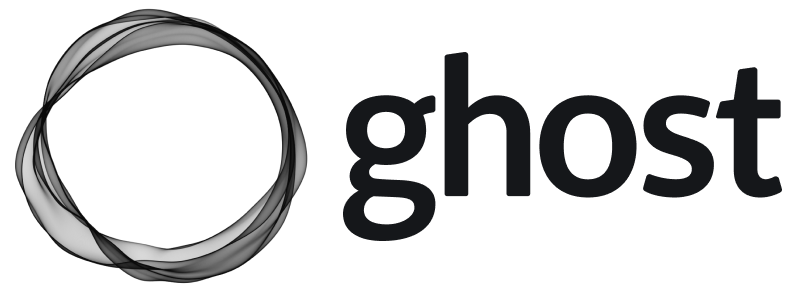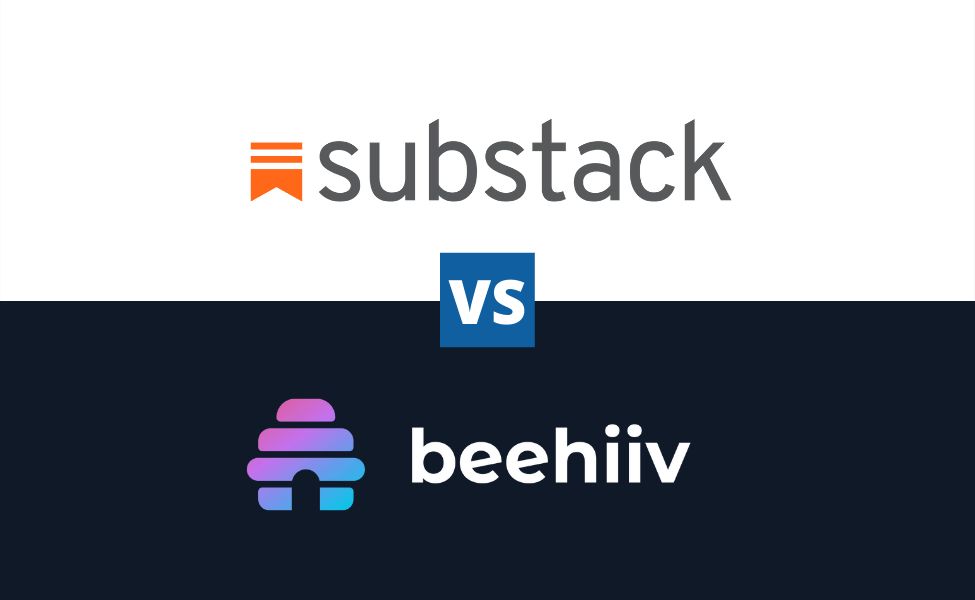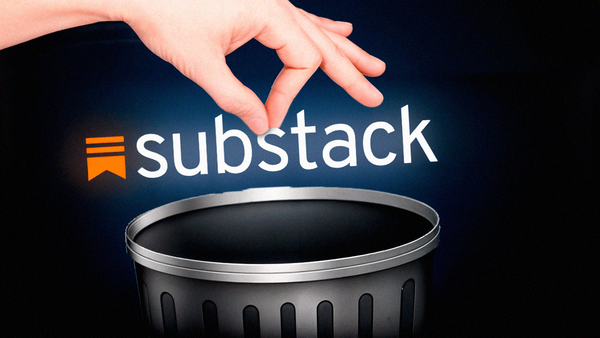Ghost vs Substack: blog vs newsletter, the full comparison
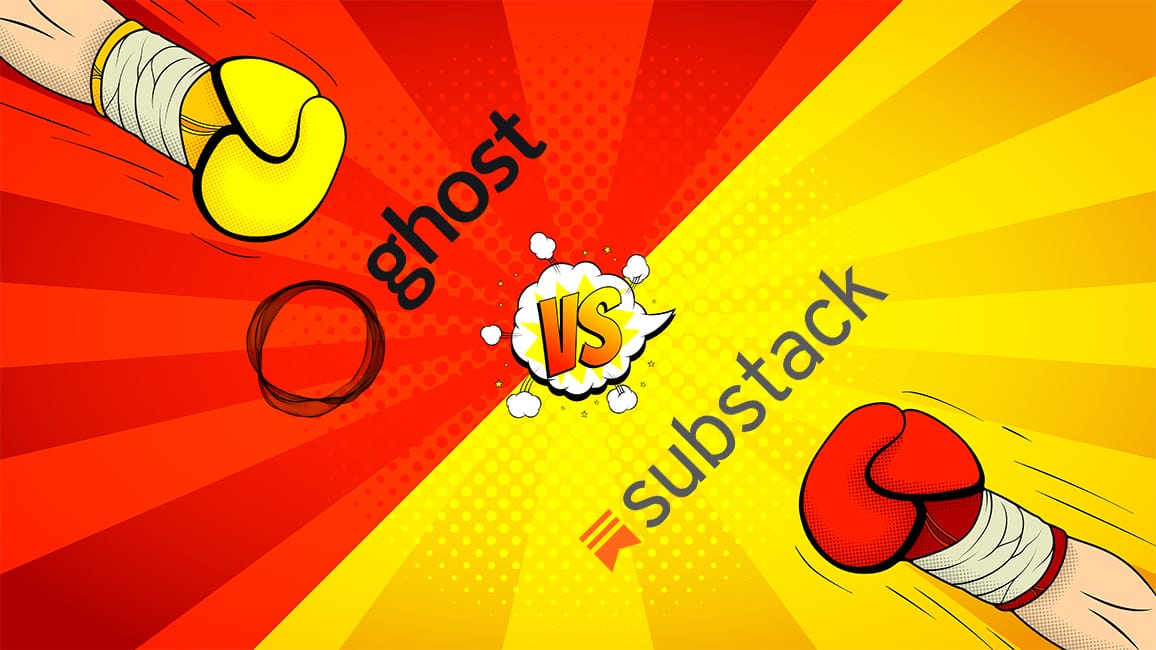
Do you feel stuck picking between Ghost vs Substack for your newsletter?
These are 2 of the most popular options for creators for a reason.
Substack is free and super simple to use, while Ghost doesn't have fees, has great SEO, and has many more tricks up its sleeves.
Keep reading to find out what you need to know to make the right choice for your newsletter.
Ghost vs Substack summary
The main difference is that Substack is a no-code platform for creators to send newsletters and interact with subscribers, while Ghost CMS is one of the best tools for monetizing blogs and newsletters with memberships.
Ghost and Substack look similar on the surface as they are platforms that combine blogs with newsletters. But couldn't be farther from the truth.
I recommend Ghost CMS for creators who give more importance to their blog and publishing articles as their SEO is fantastic. Also, Ghost has more customization and monetization options than Substack.
On the other hand, I recommend Substack to creators who want to publish different types of content using only 1 tool. Substack also has some social features like chats with subscribers.
Table of Contents
Ghost CMS Overview
Ghost CMS is a fantastic platform for bloggers and writers who want to publish content and monetize it with memberships.
The strongest points of Ghost are its SEO and ease of use. The best part is that Ghost is safe, fast, and optimized out of the box. So you can focus on creating the content instead of having to tweak things around.
Ghost is super easy to use with managed hosting like Ghost (Pro) because this type of service takes care of updates, backups, and installation. I've used Ghost since 2021, always with a managed hosting.
Things I like about Ghost CMS:
- 0% membership fees;
- Fantastic search engine optimization (SEO);
- The websites are fast;
- No coding knowledge required with managed hosting;
- Best writing experience on any platform I know;
- Works as blog + newsletter;
- You can self-host Ghost;
- Ghost sites are safer than WordPress;
- Integrations that work like plugins;
- Team members (editors and writers);
- Ghost themes are beautiful.
Things I don't like about Ghost CMS:
- Lack of email sequences and welcome emails;
- Self-hosting isn't intuitive (requires command-line knowledge);
- Theme customization requires coding;
- Limited newsletter analytics.
Substack Overview
Substack is a publishing platform for newsletters and blogs, with some podcast and social media capabilities called Notes. Created in 2017, Substack became popular by making it easy for writers to monetize their content via memberships.
Substack is free to use with a revenue-sharing model where they take 10% of membership earnings, which is perfect for hobby writers and beginners.
Since its launch, Substack has attracted numerous journalists, authors, and thought leaders who value its super simple interface and direct relationship with readers.
Things I like about Substack:
- Free forever plan;
- Do everything without code;
- Good safety record;
- Publish different types of content (newsletter, blog, podcast, and more);
- Easy to use.
Things I don't like about Substack:
- 10% in membership fees;
- Bad SEO;
- Custom domain costs $50;
- No integrations;
- No email sequences;
- Awful customization;
- Complicated content guidelines (you have to follow their rules or risk getting banned).
Related articles



SEO
Now, I want to analyze the search engine optimization (SEO) of Ghost and Substack.
Ghost CMS SEO
Important SEO features checklist for Ghost:
- Custom domain: Yes, you can use a custom domain;
- HTTPS: Yes;
- URL slug customization: Yes
- Meta description customization: Yes;
- Sitemap: Yes;
- Canonical tags: Yes;
- Redirects: Yes;
- Robots.txt: Yes;
- Website speed: Ghost has good results in speed tests;
Ghost is great when it comes to search engine optimization (SEO) and has all the tools required for success, even if you ran a paywalled publication (pay-to-read).
For me, SEO is Ghost's greatest strength in the categories I analyze.
As someone who has used Ghost since 2021, it has been so easy to have my blog optimized for search engines without effort. As a consequence, I am getting more and more traffic as time goes by.
There's nothing missing on Ghost when it comes to SEO, so Ghost gets a great score in the SEO category.

Subastack's SEO
Important SEO features checklist for Substack:
- Custom domain: Yes;
- HTTPS: Yes;
- URL slug customization: Yes;
- Meta description: Yes;
- Sitemap: Yes;
- Canonical tags: Yes;
- Redirects: No;
- Robots.txt: Yes;
- Website speed: Yes, website speed is good;
Substack's SEO looks decent on paper but, in practice, performs poorly.
The platform has important features like custom meta descriptions, XML sitemaps, and schema markup. But the biggest issue is that Substack publications struggle to rank well in search engines.
Writers have complained about this limitation since 2021, with minimal improvements from Substack to address the problem. Casey Newton even said that "the only way a Substack grows is through tweets. I am like 85% serious when I say this".
Substack also lacks the necessary technical SEO capabilities that advanced users need. Users cannot create redirects, customize canonical tags, or control noindex settings for individual posts. The redirects part is a big, big problem!
To show how bad is Substack's SEO, I have a question for you:
Have you seen a Substack publication on Google results without using the word "Substack" in the search? Me neither.
Substack also charges $50 to enable custom domains, which I don't appreciate (but at least the feature exists).
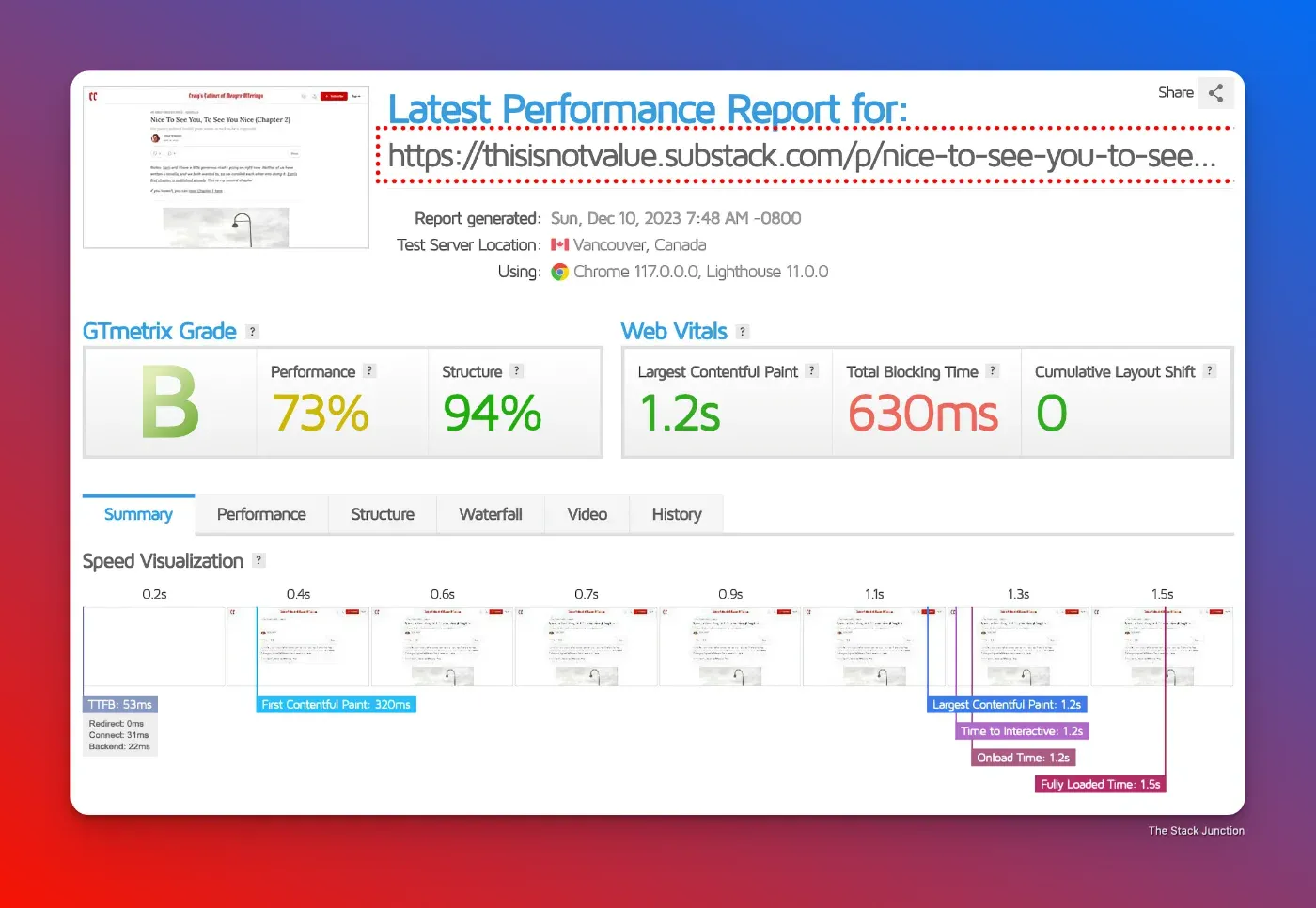
SEO Category winner
Ghost is better than Substack when it comes to SEO, and it's not even close.
Ghost CMS has all the essential tools a person needs to rank well on search engines and grow their site.
On the other side, my rating for Substack is okay. But the sad reality is that Substack performs worse than my rating suggests.
So, I recommend using Ghost and avoiding Substack if you care about SEO.
Pricing
Now comes the cost of each tool.
Ghost CMS pricing
Ghost pricing summary:
- Free plan: No;
- Cheaper plan: $9/ month for Ghost (Pro);
Ghost is open-source, meaning you can host it where you want and have some price flexibility.
Starting at $9/month, Ghost (Pro) is the easiest and best hosting option for Ghost CMS. They will take care of the installation, updates, and back process.

I've been using it since August 2022 after trying other options in the past.
If you prefer to self-host, DigitalOcean starting at $5/ month is the most popular option. But this is the path for people who know how to code and have the time to maintain the website, backups, and updates.
Substack's Pricing
Substack pricing summary:
- Free plan: Yes, Substack has free forever plan;
- Cheaper paid plan: 10% of the revenue charged via memberships;
Substack has a free forever plan with a revenue-sharing model. Instead of charging a subscription fee, Substack takes 10% of your membership revenue (plus Stripe payment processing fees).
This model is good for beginners and hobby writers since you can use Substack without spending money.
Actually, many use Substack this way.
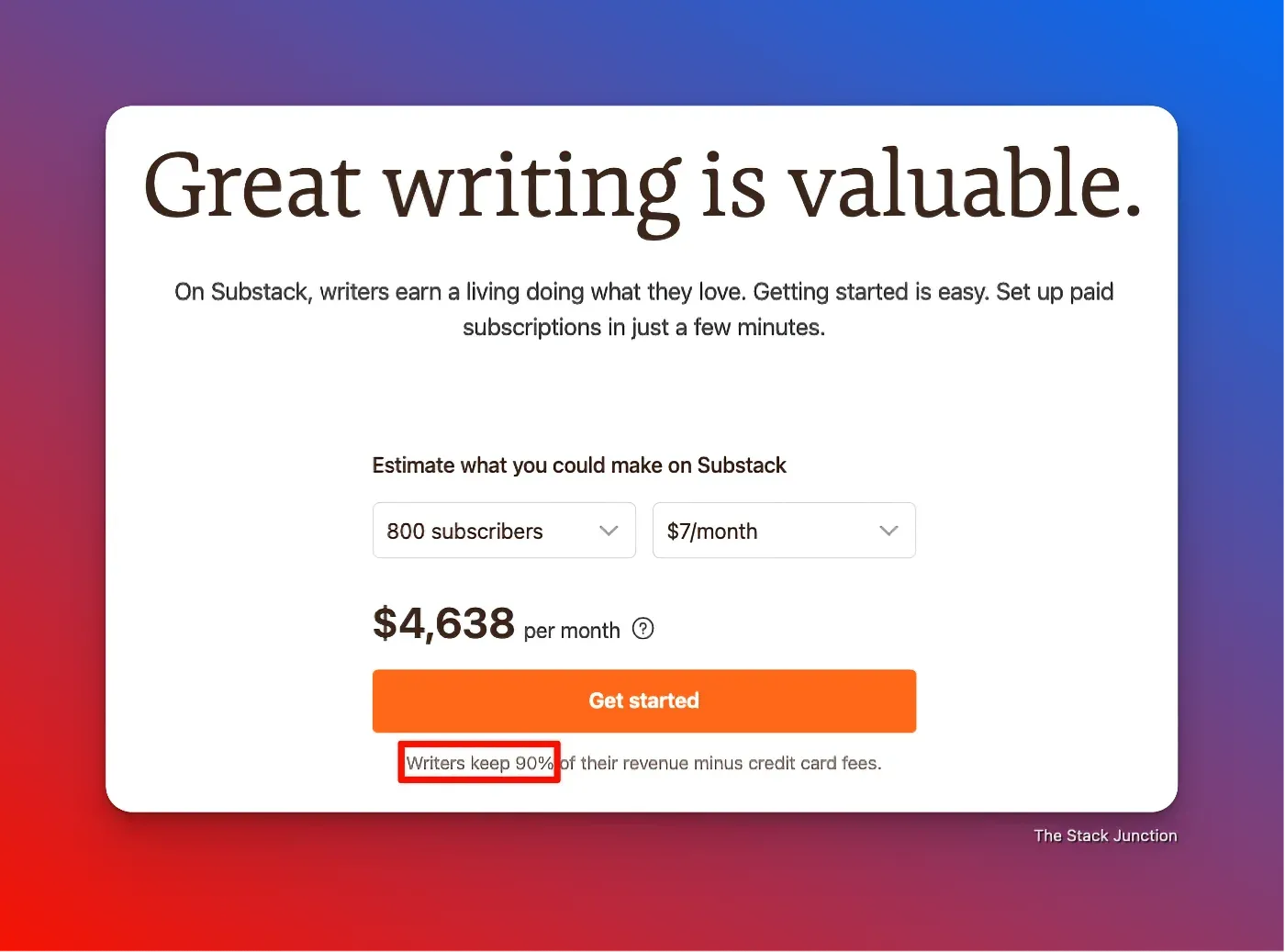
But this model is problematic, which makes creators look for cheaper Substack alternatives.
Yes, you can use Substack for free if you don't charge memberships.
However, the 10% fee becomes expensive when your subscriber base grows.
Imagine readers pay you $50 per year. This is how much Substack keeps:
| Number of subscribers | Your revenue | Substack's fees |
|---|---|---|
| 100 subscribers | $4,500 | $500 |
| 500 subscribers | $22,500 | $2,500 |
| 1,000 subscribers | $45,000 | $5,000 |
| 5,000 subscribers | $225,000 | $25,000 |
I consider these fees outrageous!
I know it's normal for platforms to have usage-based pricing, but Substack goes from being lenient with their forever-free plan to taxing the success of their writers without offering too much in return. And, you should consider if it makes sense to pay these fees.
Pricing category winner
Ghost and Substack have opposite pricing strategies. So the winner will depend on who is reading. So, I consider this category a tie.
I say a tie because Substack can be used for free without strings attached or problems. This is fantastic for a beginner on a tight budget.
On the other side, you can use Ghost to run a website for just $9/ month with support included. That's a fantastic price!
Overall, if I have to pick a winner, I give the slight edge to Ghost for not using a revenue-sharing model and because there's no ceiling on Substack costs.
But Substack will be cheaper for you if you only want to set up a free newsletter.
Monetization
Now, I'll analyze the options to make money with each platform.
Monetization on Ghost
Monetization options on beehiiv:
- Memberships: Yes
- Display ads (Programmatic advertisement like Adsense): Yes;
- e-Commerce / Digital products: No;
- Sponsorships/ Marketplace ads: No
- Donations/ Tips: No;
- Manual embed ads on content: Yes;
- Affiliate marketing: Yes.
The main monetization options on Ghost CMS are memberships and display ads.
Memberships work well for newsletters or episodic posts (think about books) and display ads to monetize informational content.
To enable membership, just go to settings, connect your Stripe account, decide the prices, and you're good to go!
For display ads, you need to put the Adsense script on the site or use the integration to start showing ads on your site.
Both of these options are super simple.
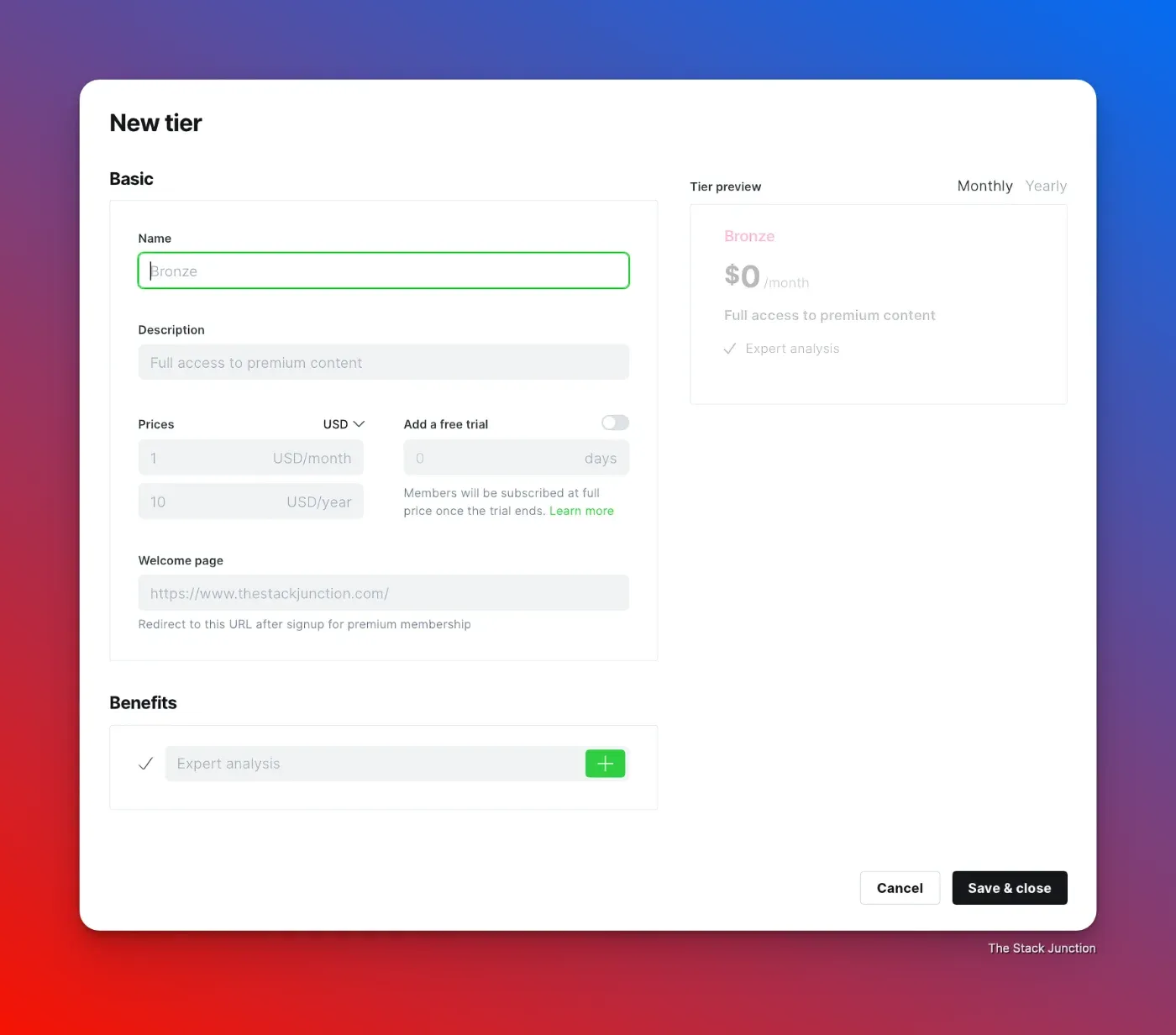
Monetization on Substack
Monetization options on Substack:
- Paid memberships: Yes
- Sponsorships/ Marketplace ads: No;
- Display ads: No;
- e-Commerce / Digital products: No;
- Donations/ Tips: No;
- Manual embed ads on content: Yes;
- Affiliate marketing: Yes.

Substack has paid memberships as the main way to monetize content. But when a creator charges for access, Substack takes a 10% cut (plus payment processing fees).
While Substack focuses on memberships, creators have found ways to earn through alternative methods. Many writers manually embed sponsored content in their posts. However, this comes with limitations, as Substack lacks tools to properly tag sponsored links, which can be problematic for SEO purposes.
Substack's monetization options are quite restricted compared to other platforms, as it doesn't support display ads or even paid recommendations.
This narrow focus on memberships means creators must rely heavily on memberships.
Monetization category winner
Ghost is better than Substack when it comes to monetization.
Both tools have memberships that are easy to use.
But Ghost has a few more options than Substack.
For example, a lot of creators make money by embedding ads in the content. But Ghost takes this further and can be used with display ads from Adsense and other networks.
Customization
Next comes customization and design.
Customization on Ghost CMS
Ghost has many themes available to pick from, and the number keeps growing.
2 of my favorite themes are Ubud (from Aspire Themes) and Rinne (from Bright Themes).
Also, if you want a custom theme, you can code it yourself or hire an expert like the inoryum agency (I've worked for them in the past) to develop a custom theme.
However, Ghost isn't a no-code website builder where you can customize everything with sliders and buttons.
Instead, you must know how to code to make most layout changes. So, it's not perfect for everyone, but at least customization is possible.
Ghost CMS also uses integrations instead of plugins. The end result is basically the same as those integrations allow adding missing features.
And there are hundreds of integrations, as Ghost can connect to almost every service, including Zapier.
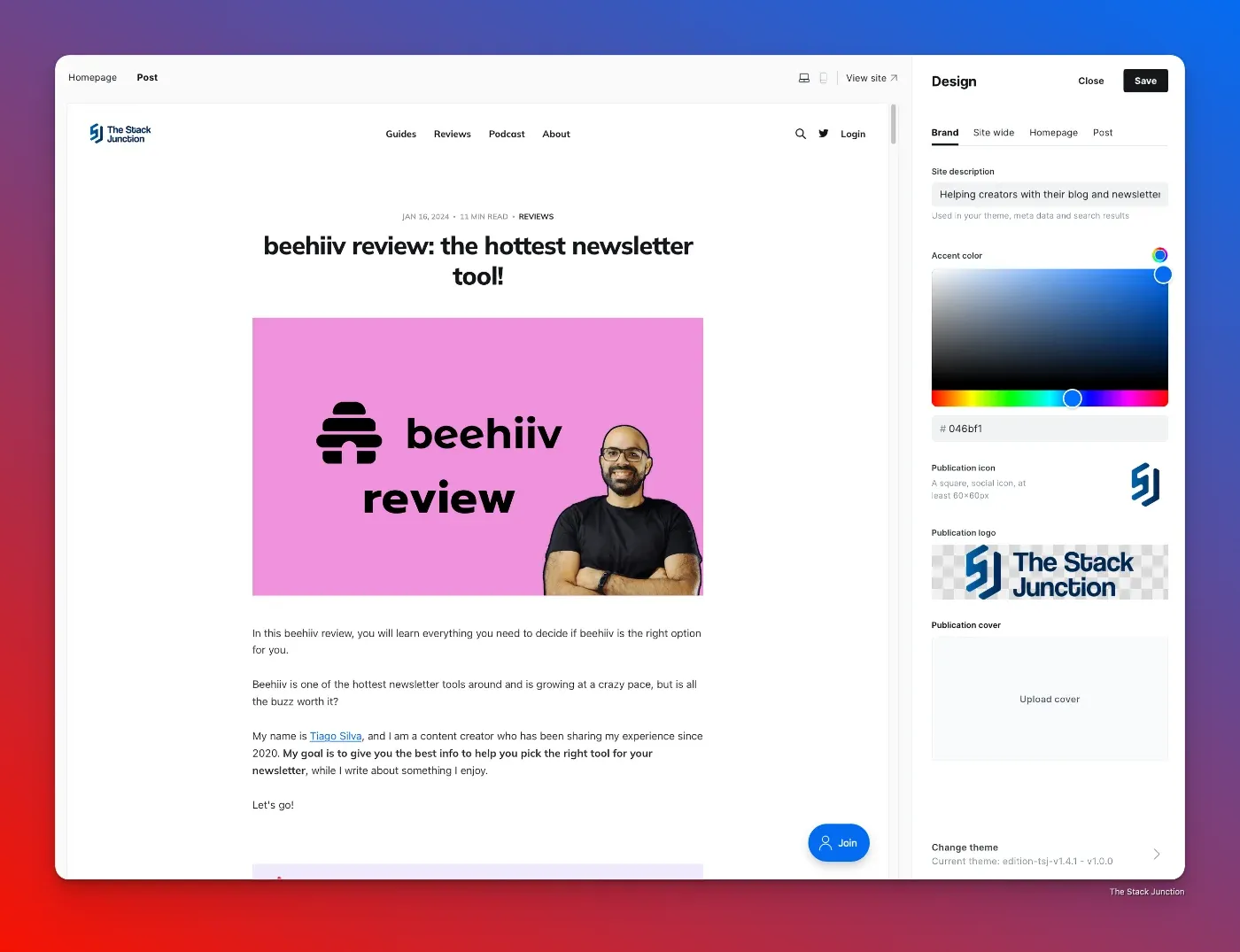
Customization on Substack
Substack's customization summary:
- Newsletter templates: No;
- Newsletter customization options: Basically none;
- Website themes: Yes, but very limited;
- Possibility to buy a theme from a 3rd-party or create one with a custom code: Only the Tripoli theme from Aspire Themes is available.
Substack's customization is extremely limited for both newsletters and websites.
You can only change basic things like fonts and colors.
Regarding layouts, there are only a handful of options. And you won't have complete control over them or advanced options.
This makes it hard to build a recognizable brand because everyone looks the same.
That's boring!
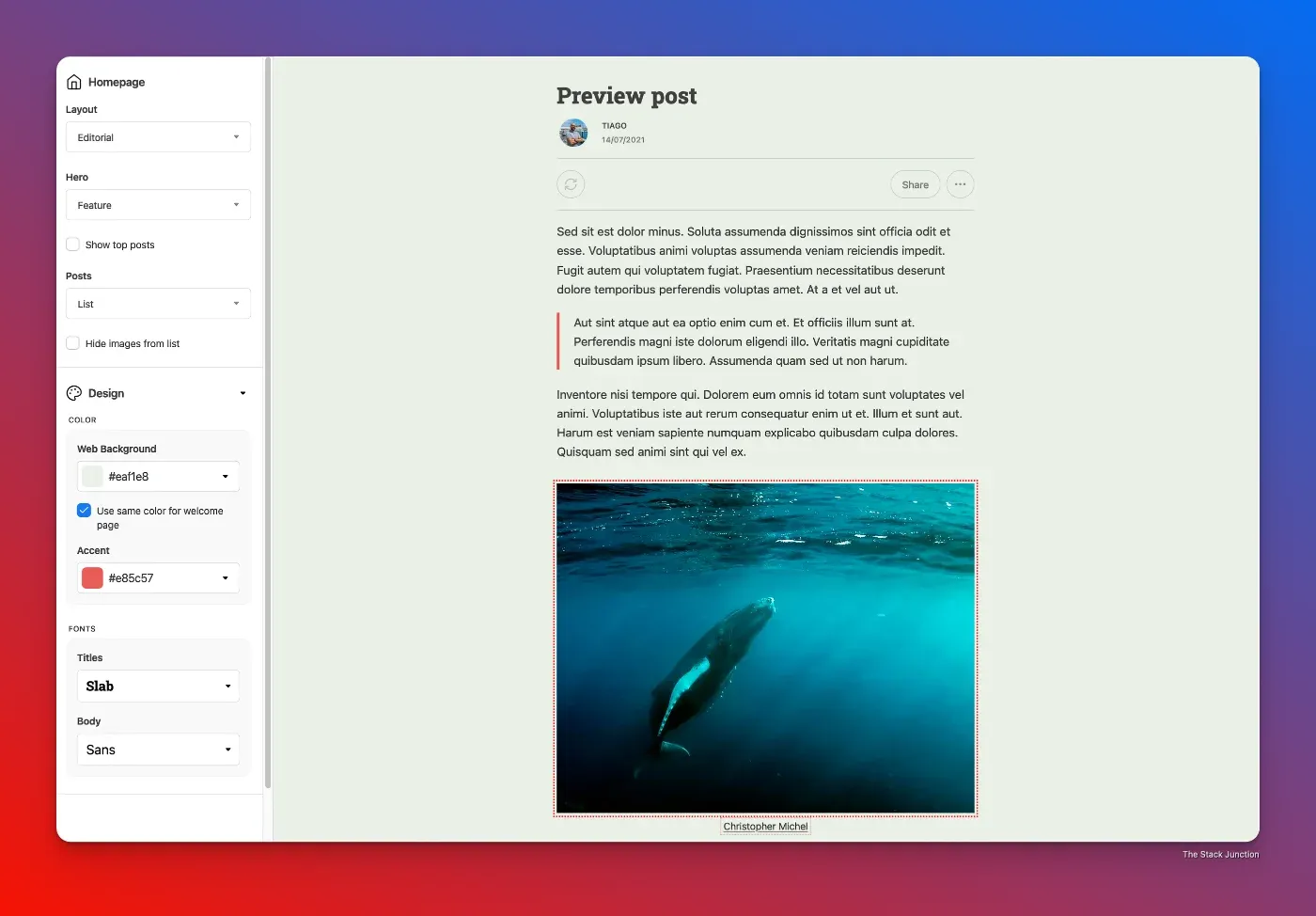
Newsletter customization is even more restrictive.
So, you can't buy or build custom themes for Substack.
To make things worse, you can't remove Substack's branding from your emails, either.
While this simplicity makes Substack easy to use, it significantly limits creators' freedom.
Customization winner
Ghost is much better than Substack regarding customization.
Substack is extremely limited, and you can only use the layouts and fonts they selected.
And this makes it harder for you to stand out and express yourself visually.
With Ghost, you can use any theme you want, built by anyone. This gives you the chance to create a unique theme that suits your blog or newsletter.
Content Creation
Now, I'll explore the process of creating content with each tool.
Content Creation Experience on Ghost CMS
The content creation experience on Ghost is simple and allows you to do almost everything you want.
The text editor on Ghost is the best I've used so far. The feature list is enormous, as seen in the Ghost CMS review. In summary, Ghost editor has everything one needs to write, like:
- Custom HTML;
- Image gallery;
- Product boxes;
- Audio, Video, and File uploads;
- Buttons.
Ghost allows you to create a lot of things without code, like product review cards with descriptions and star ratings!
But what I like the most is the flexibility that Custom HTML and code injection gives us. These 2 things allow you to create any type of content on the page.
You also have different styles for callouts and quotes.
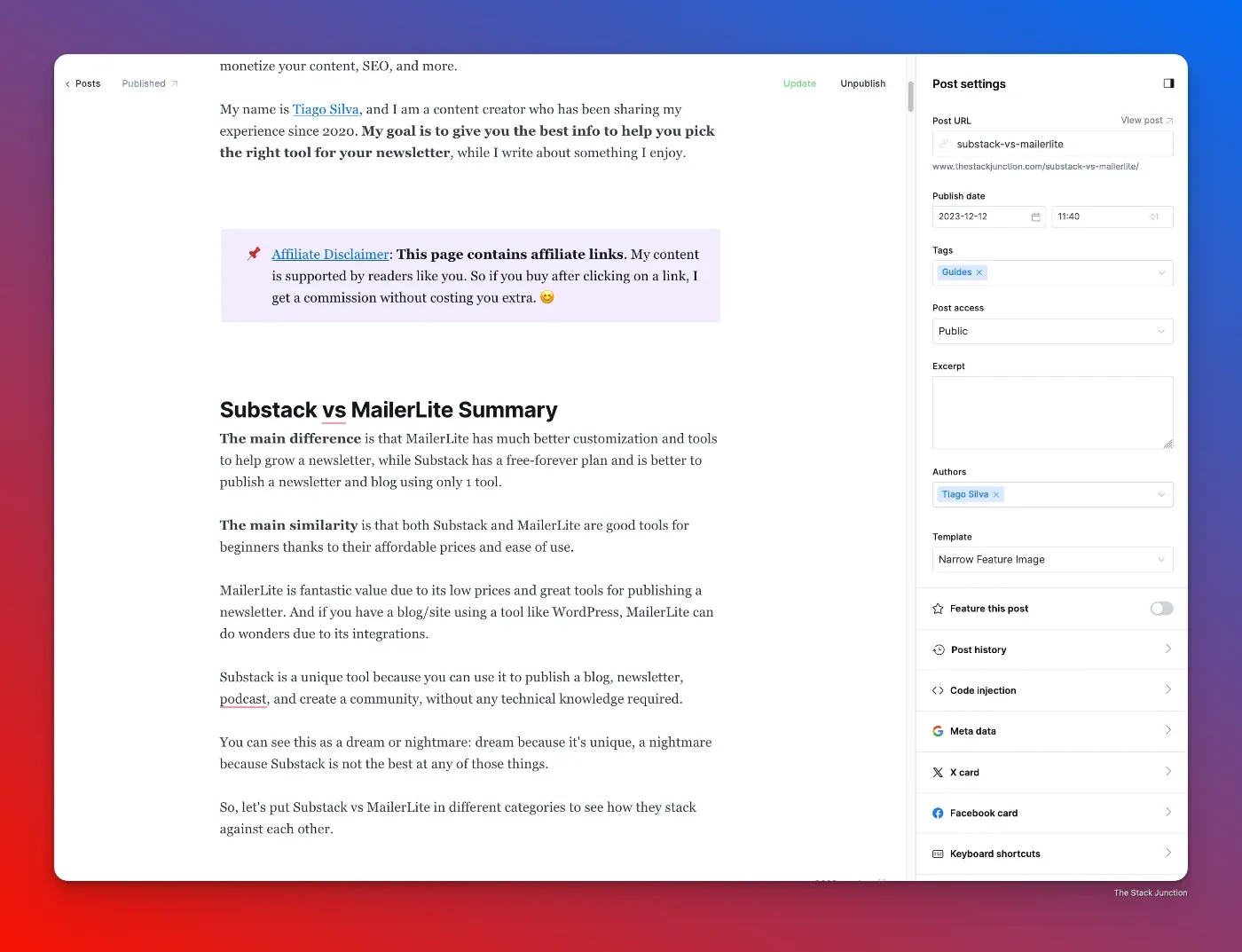
Ghost also allows multiple newsletters within the same site. This is particularly helpful if you write about topics that vary widely and could potentially interest different audiences.
For example, a news website could break down its posts into the following newsletters:
- Sports;
- Breaking News;
- Political.
As you can see, this gives many possibilities to connect with an audience.
Content Creation Experience on Substack
Content creation on Substack is simple yet limiting.
The editor has a minimalist layout with few settings at the top and nothing else on the way.
This makes it pleasant to look at and won't distract you when writing.
This is a dream for beginners because it's easy to learn and use. But frustrating for advanced users.
For example, adding custom HTML on Substack is a pain and can only be done with Google Tag Manager.
This isn't optimal from a privacy perspective and is too complicated for a thing that should be available by default.
For me, this is a big turn-off about Substack.
As a creator, I need the ability to add custom HTML, CSS, and inject JavaScript into some of my posts. I need these things for embedding forms, making tables, and writing code for sponsored tags.
Other important things missing on Substack are:
- Exclusive email content;
- Content toggles;
- Saving content as reusable blocks.
Substack also allows the creation of content with Notes (their Twitter-like social feature) and podcast publishing.

Content Creation Category winner
Ghost is better than Substack in the content creation category.
In general, you have to use Substack as it is. You can't extend its features by using integrations or plugins. This is a significant limitation, especially considering the limited features in their editor.
On the other hand, Ghost is fantastic for writing and won't hold you back.
The editor on Ghost CMS clean and has almost everything you need. And when a feature is missing, you can add it with Custom HTML.
Growth
Let's see how Substack and Ghost compare when it comes to growth tools.
Ghost Growth tools
Ghost's most important Growth tools checklist:
- Plugins/integrations: Yes;
- Automated email sequences: No;
- Referral program: Only using an integration;
- Subscriber segmentation: Yes;
- Custom sending domain: Yes;
- A/B testing (titles): No;
- RSS feed: Yes;
When it comes to Growth, Ghost is good but not great.
Ghost has a huge list of integrations, and these work as plugins and allow you to do several things, like:
- create your own referral program;
- create email automation;
- and more.

Those 2 examples (referral program and email automation) are 2 important things when it comes to 'Growth' that Ghost doesn't have by default, and why I give it a lower score.
Yet, in August 2022, Ghost released a discovery feature. This means more opportunities for more people to find publications from the Ghost main website.
Plus this has the potential SEO benefit of getting a link from a respected source (ghost.org).
Substack Growth tools
Substack's most important Growth tools checklist:
- Plugins/integrations: No;
- Automated email sequences: No;
- Referral program: No;
- Subscriber segmentation: Limited (only segments between free and paid);
- Custom sending domain: No;
- A/B testing (titles): No;
- RSS feed: Yes;
Growing a Substack publication has been the biggest problem since forever.
Where do I even start...
The platform doesn't have email automation, A/B testing for titles, and subscriber segmentation is very limited.
To counter these flaws, Substack developed its internal Discovery tool and its Twitter-clone called Notes.
This move towards a more social approach makes Substack a unique tool. It also increases the power of their network as more writers use Notes.
In 2022, Substack also released newsletter recommendations. This lets one writer recommend another newsletter to its subscribers.
While this creates network effects where creators can help each other grow, it's one of the few growth features available.
Growth Category winner
Ghost is better than Substack when it comes to growth, despise Ghost being only okay at this.
From a technical point of view, growth tools are non-existent on Substack. This has been a massive flaw of them that hasn't been fixed or improved upon since 2021 (that I know).
While Ghost is okay at growth tools, you can always use integrations with 3rd-party tools to add missing functionality.
And that's why Ghost is better regarding growth.
Final Thoughts
This article showed that Ghost CMS is miles better than Substack, and it's not even close.
My advice is to pick Ghost CMS if you want a great tool for blogging. It has better SEO, customization options, monetization options, and more freedom for advanced users.
While Substack is the biggest responsible for making newsletters cool again. And became the standard option for non-technical users to start writing online.
For me, there are only 2 reasons to pick Substack over Ghost:
- You don't have any money to pay for Ghost CMS at the moment;
- You want to publish different types of content on the same platform (podcast, newsletter, etc.) and see Substack as the perfect place to publish everything you need and be easy to talk with subscribers.
In every other scenario, Ghost will be the better option for you. Click on the button below and start your account today!


